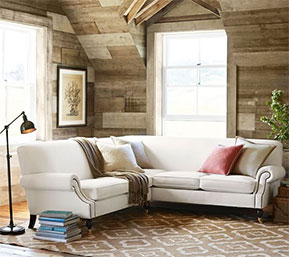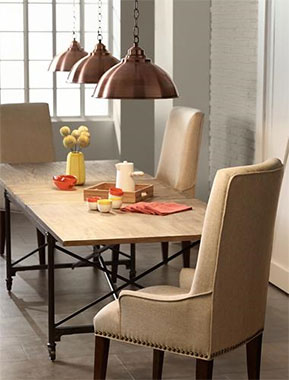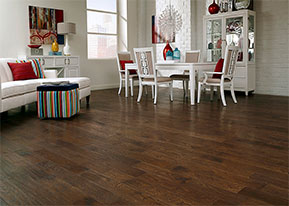How to Enhance an Open Floor Plan
by Rachel Lyon, Editorial Director for Direct from the Designers™
The open floor plan is a fantastic element of modern design that has been incorporated into just about every architectural style. Interior designers and homeowners love the flexibility of this layout, which removes walls to create a larger, brighter, breezier space that encompasses the kitchen, dining room, and living room. What you get is an expansive general great room, which ensures that you use more of your square footage to the fullest at any given time, but sometimes it seems tricky to furnish this wide open swath of living space. Designs can look hollow, flat, and unbalanced if care isn’t taken to subtly distinguish the different areas, but you still want them to flow together—because that’s the whole point! Here are some tips to help you make the most of an open floor plan, so you can enjoy the best this layout has to offer.
Create General Borders
Just because interior walls have been done away with doesn’t mean an open floor plan is supposed to be unstructured—it’s just up to you to impose your own structure without relying on barriers that are part of the house itself. The point isn’t to have a vast, empty room; you want to be able to see between spaces but still feel like you have somewhat focused zones.
Think about the increase in interest for island kitchens over the years. They don’t just give you more counter and cabinet space—they are placed there as dividers, and that’s why you’ll find islands in open floor plans. Take a hint from the architect who designed your home and continue this kind of delineation for the living and dining rooms with furnishings that you choose yourself! Your home will still keep its spacious, flowing feel because sightlines will remain unimpeded, but the different areas will be emphasized individually.
That said, place furniture in a way that facilitates conversation in the living space. The best way to do this varies on the shape and layout of each great room, but the general rule of thumb is to direct attention inward. Think about placing seating around a coffee table, like you would in any living room, but place the backs of chairs and couches to the kitchen and/or dining room. Many times, you’ll end up with an L- or U-shaped arrangement, but you can also have two straight lines of furniture facing each other, with their sides toward the kitchen. Just like how kitchen island seating always faces into the kitchen, you want this seating to create a living space border that directs inward.
Use Lighting to Differentiate Zones
Think about the ambient lighting in your home. Chances are, you have multiple light switches for your great room, and that each controls a small section. You should think about how to supplement basic recessed lighting in a way that further defines each space. This kind of localized task lighting shouldn’t necessarily be extreme, but it should be clear that you’re setting up a sort of boundary with illumination—and the best part is that you can turn it on or off based on your needs.
Background light from windows and the ceiling gives you a good base layer to work with, because putting a spotlight on one area while the rest is dark would be pretty jarring. Look for lamps as well as pendant and track lighting to highlight spaces individually. Place any hanging fixtures over surfaces you gather around—the kitchen island, dinner table, coffee table—to draw attention inward, or take a more dramatic approach by directing track lighting on a space from the outside. Decide how subtle or intense you want the effect to be, and take your house style into account, too. You can get pretty sharp with a contemporary home, but a gentler approach is better for a cottage with a great room.
Keep a Coherent Foundation
With all this talk of defining the different parts of the great room, you might be wondering if everything should just be cut and marked separate. Just like with the clear sightlines that keep the room feeling spacious, you want there to be something that connects the different areas so they don’t seem fragmented. In the broadest terms, your background color scheme should be carried throughout everything from the floor to the ceiling.
It’s easy enough to accept a certain paint palette for the whole house, but there are so many types of flooring available. We have preconceived ideas for what works in different rooms, so it only seems right that the kitchen, at least, have something different. Resist the urge! Try to find flooring that you can see used in the entire great room, so there’s a solid base to your design. There are plenty of attractive and durable options that will look great and hold up to your demands, so be sure to look for them. Maybe an exceptionally hardy hardwood, engineered wood that resists scuffing and water damage, or even wood-look tile that gives you natural beauty with impressive resilience could be your perfect great room floor!
Your design foundation helps your open floor plan flow through its different spaces, but what you build on it and how you highlight will affect how functional each part is individually. If it’s divided up too much, it will feel disjointed and perhaps you should have chosen a traditional floor plan instead, but if there isn’t any focus, your living areas will seem big and amorphous, and might make you feel uncomfortable or distracted. Find a happy medium so you can enjoy a nice, balanced great room.
BROWSE HOME PRODUCT ARTICLES
- Creating a Spa-Like Master Bathroom »
- Designing a Water-Efficient Bathroom »
- Design a Modern Bathroom »
- View All Bathroom Articles »
- Building a New Home »
- Building a Duplex »
- Finding the Right Home Builder »
- View All Building Tips Articles »
- Adding the Right Columns»
- Decorative Touches for Your Interior»
- Shutters for Every Architectural Style »
- View All Columns & Millwork Articles »
- How to Use Specialty Laminates »
- Decorative Touches for Your Home's Interior
- View All Countertops and Surfaces Articles »
- What Goes Into a Great Deck? »
- Decorative Touches for Your Home's Interior »
- View All Decking Articles »
- Choosing Glass for Your Entry »
- Stylish Personas for Your Front Door »
- Using Sidelites and Transoms »
- View All Door Articles »
- Choose Siding for Your Region »
- Get the Most Out of Exterior Paint »
- Mixing Siding to Define Your Exterior »
- View All Exterior Articles »
- Finding the Right Home Builder »
- The Appeal of Small House Plans »
- Choosing the Perfect Floor Plan »
- View All Finding a Home Plan Articles »
- Colorful Flooring for Your Home »
- Designing With Different Widths»
- Chic, Neutral, Gray Flooring »
- View All Flooring Articles »
- Garage Doors That Add Curb Appeal »
- Caring for Your Garage Doors »
- Benefits of Insulated Garage Doors »
- View All Garage Door Articles »
- Reclaimed Products for Your Home »
- Building a Green and Stylish Home »
- Benefits of Building with SIPS »
- View All Green Building Articles »
- Cool Gadgets for Your New Home »
- Creating a Hi-Tech Home »
- Efficient Gifts for New Homeowners »
- View All Home Electronics Articles »
- Improve Your Home's Air Circulation »
- How to Improve the Air Circulation in Your Home »
- View All HVAC Articles »
- Bedrooms Designed for Sleep »
- Selecting a Fireplace for Your Home »
- Crafting a Luxurious Master Suite »
- View All Interior Design Articles »
- Design the Perfect Outdoor Space »
- Dive into a Beautiful Pool »
- Design a Sizzling Outdoor Kitchen »
- View All Outdoor Living Articles »
- Apps to Help You Pick Paint Colors »
- Create the Perfect Mood with Paint »
- How to Read the Color Wheel »
- View All Painting & Decorating Articles»
- Creating a Spa-Like Master Bathroom »
- High-Impact Kitchen Upgrades »
- Creating a Water Efficient Bathroom »
- View All Plumbing Fixtures Articles»
- Cladding That Complements Your Exterior »
- Reasons to Consider Prefinished Siding »
- View All Siding & Cladding Articles»
- All About Solar Powered Skylights »
- Natural Lighting for the Dark Corners of Your Home »
- Design a Better Bedroom with Skylights »
- View All Skylight Articles»




